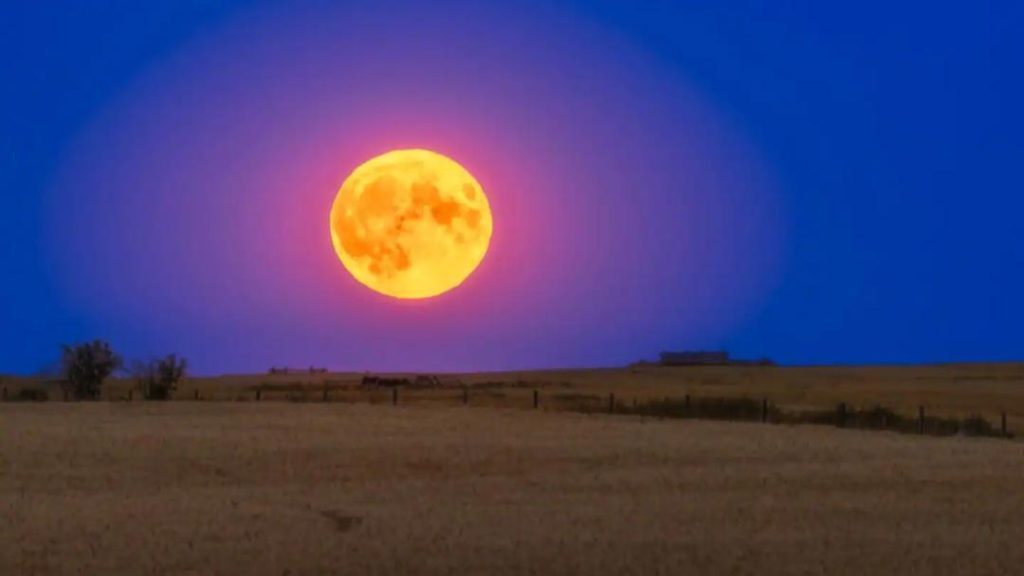
Buck Moon to Light up Skies on July 10 & 11
The Buck Moon, also known as July’s full moon, is just around the corner, and astronomy enthusiasts are eagerly waiting to catch a glimpse of this celestial phenomenon. The Buck Moon is named by Native American tribes, specifically the Algonquin, who believed that this full moon marked the time when male deer, or bucks, begin growing new antlers. This year, the Buck Moon will peak at 3:08 am IST on July 11 in India and at 4:38 pm EDT on July 10 in the US.
The Buck Moon is one of the most anticipated full moons of the year, and its peak timing is expected to be a treat for stargazers. The moon will be at its brightest and most visible in the night sky, making it an ideal time for moon-gazing and astronomical observations.
But the Buck Moon won’t be the only celestial attraction on July 10 and 11. Mars, Venus, and Saturn will also be visible in the sky before and after the moon peaks, offering a thrilling opportunity for astronomers to observe these planets up close.
Astronomical Significance of the Buck Moon
The Buck Moon is a significant event in the astronomical calendar, marking the midpoint of the summer solstice in the Northern Hemisphere. The full moon’s timing is closely tied to the lunar cycle, which takes approximately 29.5 days to complete. The Buck Moon’s peak is a result of the lunar cycle’s synchronization with the Earth’s rotation and orbit around the sun.
The Buck Moon’s association with the antler growth of male deer is rooted in the ancient traditions of Native American tribes. According to Algonquin mythology, the Buck Moon marked a time of great abundance and fertility, as the deer’s new antlers symbolized strength and vitality. This mythological significance has been passed down through generations, making the Buck Moon a revered and culturally important event.
How to See the Buck Moon
The Buck Moon will be visible in the night sky on July 10 and 11, and astronomers can observe it from most parts of the world. Here are some tips to help you catch a glimpse of this celestial spectacle:
- Find a dark location: The Buck Moon will be visible in the night sky, but it’s essential to find a dark location with minimal light pollution to maximize your viewing experience.
- Timing is everything: The Buck Moon will peak at 3:08 am IST on July 11 and 4:38 pm EDT on July 10. Plan your viewing accordingly to ensure you’re in the right location at the right time.
- Bring binoculars: Binoculars can enhance your viewing experience by allowing you to get a closer look at the moon’s craters and surface features.
- Join a stargazing event: Many astronomy clubs and organizations are hosting stargazing events on July 10 and 11. Join one of these events to meet fellow astronomy enthusiasts and learn more about the Buck Moon.
Additional Planetary Sightings
The Buck Moon won’t be the only celestial attraction on July 10 and 11. Mars, Venus, and Saturn will also be visible in the sky, offering a thrilling opportunity for astronomers to observe these planets up close. Here are some details about the planetary sightings:
- Mars: Mars will be visible in the eastern sky around 10 pm on July 10 and 11. Look for the bright red planet, which will be at a distance of approximately 225 million kilometers from Earth.
- Venus: Venus will be visible in the western sky around 9 pm on July 10 and 11. The planet will be at a distance of approximately 110 million kilometers from Earth, making it a stunning sight in the night sky.
- Saturn: Saturn will be visible in the southeastern sky around 2 am on July 11. Look for the ringed planet, which will be at a distance of approximately 1.4 billion kilometers from Earth.
Conclusion
The Buck Moon is a significant event in the astronomical calendar, marking the midpoint of the summer solstice in the Northern Hemisphere. This year, the Buck Moon will peak at 3:08 am IST on July 11 and 4:38 pm EDT on July 10, offering a thrilling opportunity for astronomers to observe this celestial phenomenon. Mars, Venus, and Saturn will also be visible in the sky, making this a special event for stargazers. So mark your calendars, grab your binoculars, and get ready to witness the Buck Moon in all its glory!
Source:
https://www.newsbytesapp.com/news/science/buck-moon-2025-when-how-to-see-july-s-full-moon/story






